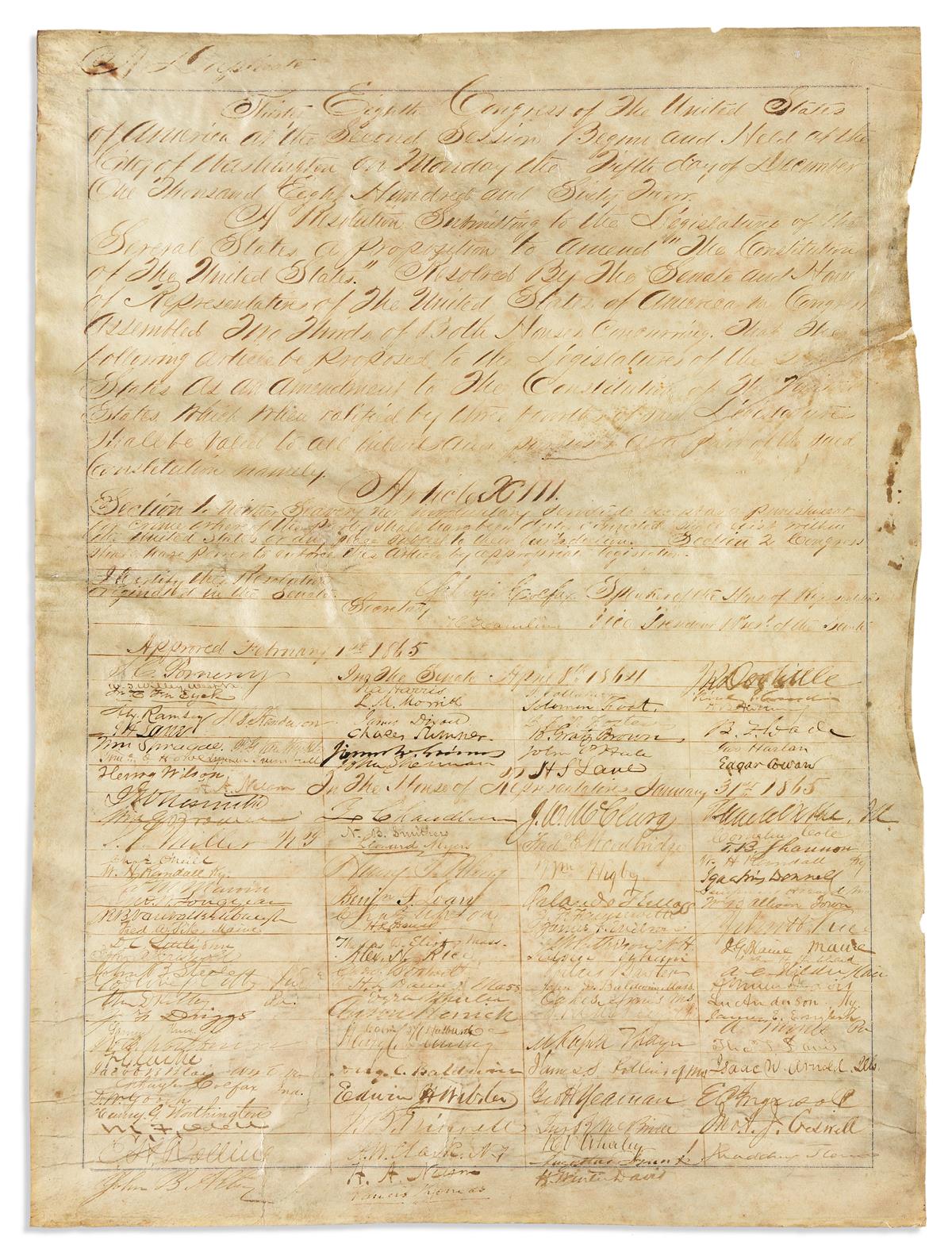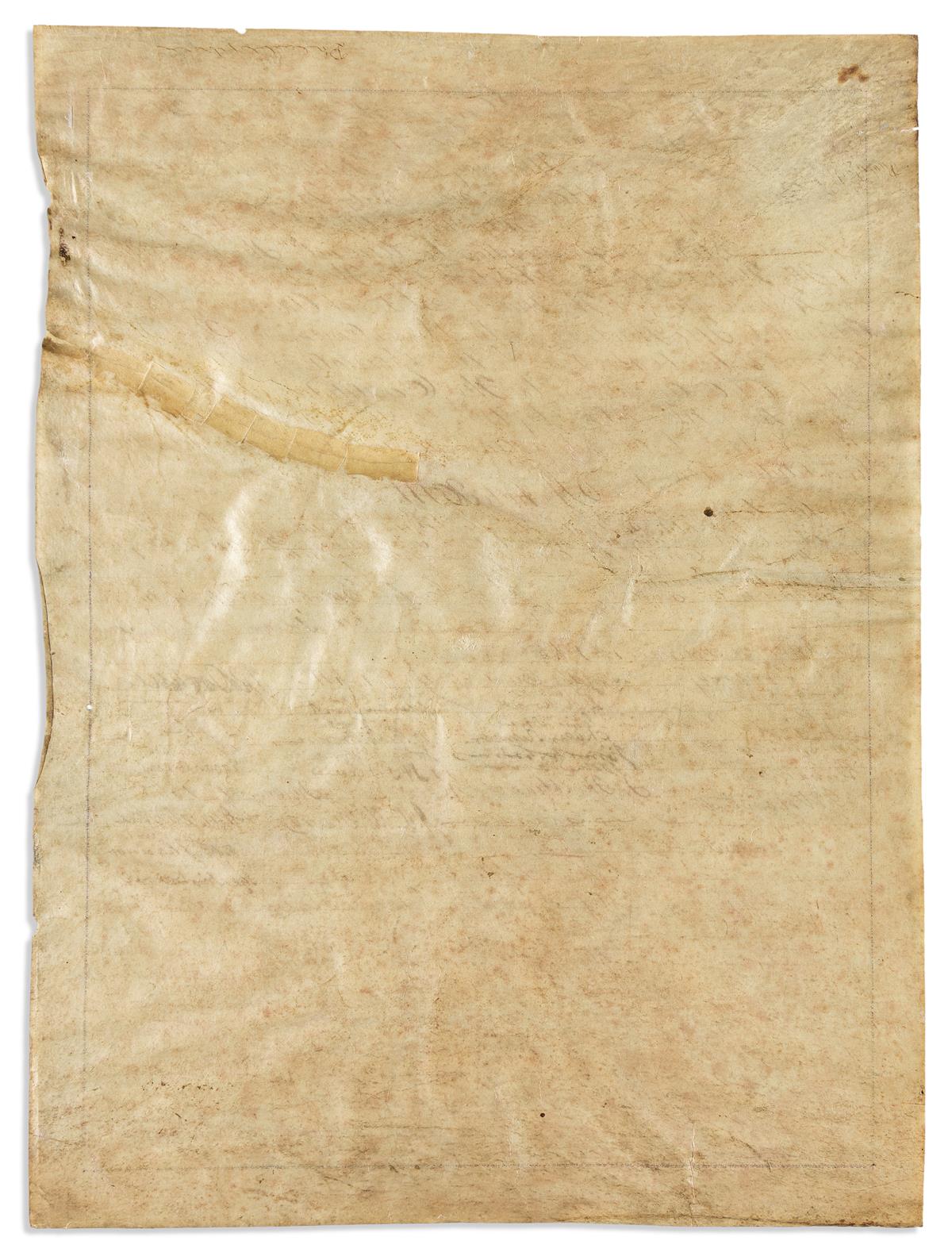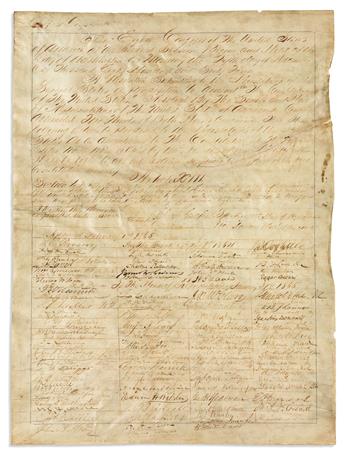Sale 2631 - Lot 77
Price Realized: $ 42,000
Price Realized: $ 52,500
?Final Price Realized includes Buyer’s Premium added to Hammer Price
Estimate: $ 80,000 - $ 120,000
(SLAVERY & ABOLITION.) Manuscript broadside of the 13th Amendment signed by the Vice President and 111 congressmen. Manuscript document bearing 117 signatures, including Vice President Hannibal Hamlin, 31 Senators (all in the top 6 rows), and 80 different Representatives plus 5 duplicates including Speaker of the House Schuyler Colfax. One page, 20 3/4 x 15 1/4 inches, on vellum, with faint red and blue lined border; 7-inch repaired tear above the amendment text, light staining and wrinkling, lone wormhole along right border. Washington, 1 February 1865
Additional Details
The 13th Amendment abolished slavery in the United States, north and south. Its passage by Congress was an arduous process, clearing the House of Representatives by a two-vote margin after months of arm-twisting by President Lincoln and abolitionist congressional leaders. To celebrate this moment, several unofficial copies of the resolution were drafted and sent around for the signatures of its supporters in Congress. The main text reads:
"A duplicate. Thirty-Eighth Congress of the United States. . . . A resolution submitting to the legislatures of the several States a proposition to amend the Constitution of the United States. Resolved by the Senate and House of Representatives of the United States of America in Congress assembled, two-thirds of both Houses concurring, that the following article be proposed to the legislatures of the several States as an amendment to the Constitution of the United States, which, when ratified by three-fourths of said legislatures, shall be valid, to all intents and purposes, as a part of the said Constitution, namely:
Article XIII. Section 1. Neither slavery nor involuntary servitude, except as a punishment for crime whereof the party shall have been duly convicted, shall exist within the United States, or any place subject to their jurisdiction. Section 2. Congress shall have power to enforce this article by appropriate legislation."
The amendment passed the Senate with 38 votes in April 1864, but then faced a long fight in the House. Months later on 31 January 1865, it barely reached the necessary two-thirds in the House of Representatives with 119 votes (58 opposed). As a courtesy, the official copy of the resolution was sent to the White House for Lincoln's approval, although that was not required by the Constitution; it remains the only constitutional amendment signed by a president. In the present commemorative copy, a space was left open for President Lincoln in the center of the document, after "Approved February 1st 1865." This suggests that signatures were still being gathered on this copy when Lincoln was shot on 14 April.
Among the more notable signers are Vice President Hannibal Hamlin; Speaker of the House Schuyler Colfax of Indiana; future presidential candidate James Blaine of Maine; prominent abolitionists Thaddeus Stevens of Pennsylvania (in the lower right corner) and Charles Sumner of Massachusetts; John B. Henderson of Missouri, who had introduced the bill in the Senate; and James M. Ashley of Ohio, who introduced the bill in the House and led the effort to wrangle the final votes. The great bulk of the amendment's supporters were Republicans, but several Democrats crossed the aisle to secure its passage. Some of them signed the present document, including the only two Democratic supporters in Senate (Reverdy Johnson of Maryland and James Nesmith of Oregon); Ezra Wheeler of Wisconsin--the only Democrat to make a speech in favor of the amendment on the House floor; and early House supporters John A. Griswold and Moses F. Odell of New York. Also appearing is George Helm Yeaman of slave-holding Kentucky, who cast what proved to be the deciding vote. A complete list of signers is available upon request.
References: Donald Mugridge, "Neither Slavery nor Involuntary Servitude," describing another copy held by the Library of Congress, in The Library of Congress Quarterly Journal 5:4 (August 1948).
"A duplicate. Thirty-Eighth Congress of the United States. . . . A resolution submitting to the legislatures of the several States a proposition to amend the Constitution of the United States. Resolved by the Senate and House of Representatives of the United States of America in Congress assembled, two-thirds of both Houses concurring, that the following article be proposed to the legislatures of the several States as an amendment to the Constitution of the United States, which, when ratified by three-fourths of said legislatures, shall be valid, to all intents and purposes, as a part of the said Constitution, namely:
Article XIII. Section 1. Neither slavery nor involuntary servitude, except as a punishment for crime whereof the party shall have been duly convicted, shall exist within the United States, or any place subject to their jurisdiction. Section 2. Congress shall have power to enforce this article by appropriate legislation."
The amendment passed the Senate with 38 votes in April 1864, but then faced a long fight in the House. Months later on 31 January 1865, it barely reached the necessary two-thirds in the House of Representatives with 119 votes (58 opposed). As a courtesy, the official copy of the resolution was sent to the White House for Lincoln's approval, although that was not required by the Constitution; it remains the only constitutional amendment signed by a president. In the present commemorative copy, a space was left open for President Lincoln in the center of the document, after "Approved February 1st 1865." This suggests that signatures were still being gathered on this copy when Lincoln was shot on 14 April.
Among the more notable signers are Vice President Hannibal Hamlin; Speaker of the House Schuyler Colfax of Indiana; future presidential candidate James Blaine of Maine; prominent abolitionists Thaddeus Stevens of Pennsylvania (in the lower right corner) and Charles Sumner of Massachusetts; John B. Henderson of Missouri, who had introduced the bill in the Senate; and James M. Ashley of Ohio, who introduced the bill in the House and led the effort to wrangle the final votes. The great bulk of the amendment's supporters were Republicans, but several Democrats crossed the aisle to secure its passage. Some of them signed the present document, including the only two Democratic supporters in Senate (Reverdy Johnson of Maryland and James Nesmith of Oregon); Ezra Wheeler of Wisconsin--the only Democrat to make a speech in favor of the amendment on the House floor; and early House supporters John A. Griswold and Moses F. Odell of New York. Also appearing is George Helm Yeaman of slave-holding Kentucky, who cast what proved to be the deciding vote. A complete list of signers is available upon request.
References: Donald Mugridge, "Neither Slavery nor Involuntary Servitude," describing another copy held by the Library of Congress, in The Library of Congress Quarterly Journal 5:4 (August 1948).
Exhibition Hours
Exhibition Hours
Aliquam vulputate ornare congue. Vestibulum maximus, libero in placerat faucibus, risus nisl molestie massa, ut maximus metus lectus vel lorem.






